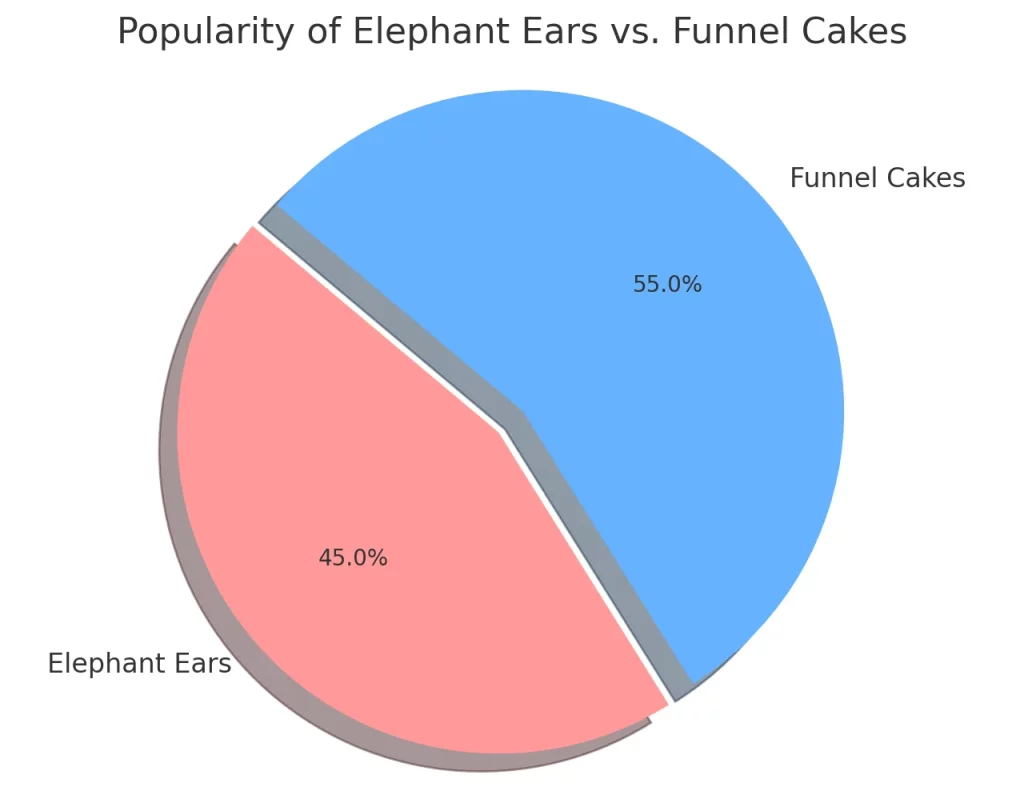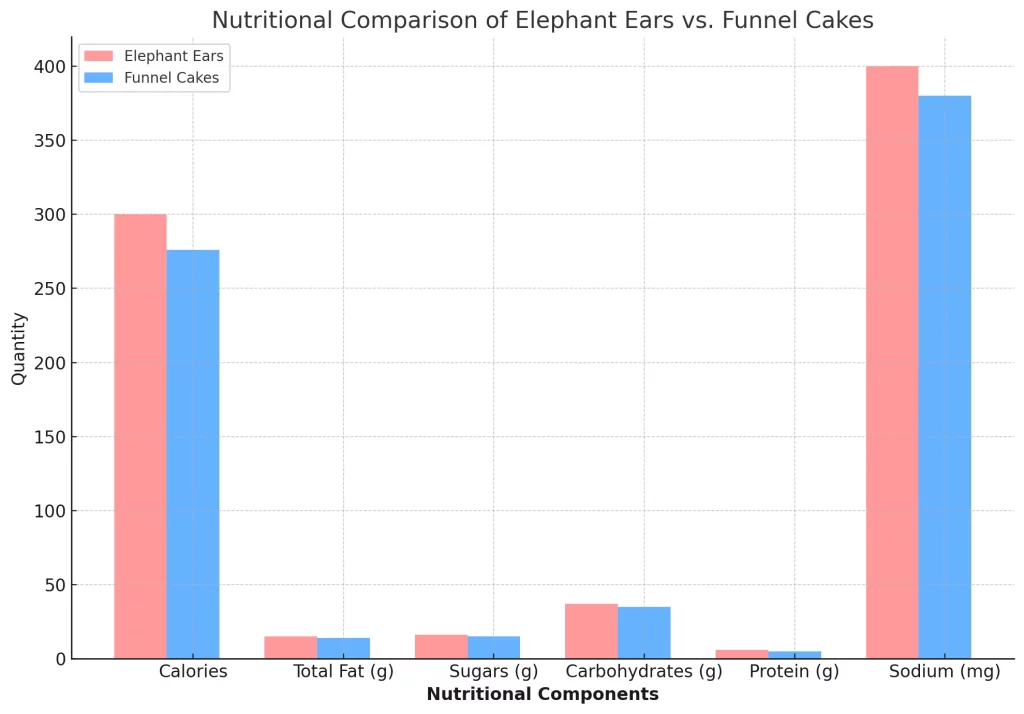Difference Between Elephant Ear and Funnel Cake: Which Fair Favorite Wins the Crown?

When you think of fair food, two treats often come to mind: elephant ears and funnel cakes. But what’s the essential difference between elephant ear and funnel cake? While both are deep-fried delights, they boast distinct flavors, ingredients, and preparations. This article aims to settle the debate once and for all.
🔍 Quick Overview:
- Elephant Ears: Large, flat pieces of fried dough, often covered in cinnamon and powdered sugar.
- Funnel Cakes: Made by pouring batter into hot oil through a funnel, resulting in a lace-like, crispy dessert, typically topped with powdered sugar.
Note: Both these desserts are iconic carnival foods, but knowing their distinctions ensures you make the perfect choice on your next visit!
🎪 At every carnival, amidst the thrilling rides and games, there’s an age-old culinary debate: elephant ear or funnel cake? The difference between elephant ear and funnel cake is not just about taste—it’s about tradition, preparation, and those sweet memories they evoke. While both are synonymous with joyous outings, understanding what sets them apart can elevate your fair food experience.
In this sweet exploration, we’ll dive deep into their histories, textures, tastes, and the cultural significance they hold. Whether you’re team elephant ear or a funnel cake fanatic, by the end of this article, you’ll have a comprehensive understanding of these two delightful desserts.
| Criteria | Elephant Ears | Funnel Cakes |
|---|---|---|
| Ingredients | Yeasted dough Sugar Cinnamon (optional for traditional flavor) Oil for frying | Cake batter (flour, eggs, milk, sugar) Baking powder Salt Oil for frying |
| Preparation Method | Roll out the yeasted dough flat Deep-fry until golden brown | Mix ingredients to form a smooth batter Pour the batter through a funnel into hot oil in a circular pattern Fry until golden brown |
| Typical Toppings | Cinnamon and sugar Chocolate Fruit (like strawberries or apples) Whipped cream | Powdered sugar Fruit sauces (like raspberry or blueberry) Chocolate drizzle Whipped cream |
How Elephant Ears and Funnel Cakes are Made
Elephant Ears
Elephant ears, often referred to as fry bread or sweet pastry dough, are a carnival staple.
- Dough: The primary ingredient is a yeasted dough that’s allowed to rise, giving the dessert its fluffy interior.
- Preparation: The dough is rolled flat, resembling the large ears of an elephant, hence the name. It’s then deep-fried until golden brown.
- Toppings: Traditionally, elephant ears are sprinkled with cinnamon and sugar. However, modern variations include toppings like chocolate, fruit, and whipped cream.
Funnel Cakes
Differing from the elephant ear, the funnel cake is all about the batter.
- Batter: The batter is typically made with cake batter, baking powder, and other ingredients to ensure a light texture.
- Preparation: The uniqueness comes from its method of frying. The batter is poured into hot oil through a bottle or funnel, creating long stringy dough lines in a circular pattern, resulting in a lace-like appearance.
- Toppings: Like its counterpart, funnel cakes are often finished with a dusting of powdered sugar, though many also enjoy them with fruit, chocolate, or other sweet drizzles.
| Characteristic | Elephant Ear | Funnel Cake |
|---|---|---|
| Base | Yeasted dough | Batter |
| Appearance | Flat, large | Lacy, with intricate patterns |
| Traditional Topping | Cinnamon and sugar | Powdered sugar |
Comparison of Funnel Cake And Elephant Ears

Taste and Texture
While both desserts are undeniably delicious, there are subtle differences:
- Elephant Ears: They tend to be chewier with a soft interior. The outer layer is crispy, complemented by the sweet toppings.
- Funnel Cakes: These are generally crispier throughout, with a delicate texture that melts in your mouth.
Appearance
As highlighted earlier:
- Elephant Ears: They are larger, flat, and often resemble the shape of an actual elephant’s ear.
- Funnel Cakes: They have a distinctive lacy appearance due to the method of pouring the batter.

Nutritional Value
While neither treat is touted for its health benefits, there are some differences:
- Elephant Ears: Slightly denser, they might have a higher calorie count, especially when loaded with toppings.
- Funnel Cakes: Lighter in nature, but it’s the toppings that can quickly add to its calorie content.
Preparation Time and Difficulty
Both desserts require some skill:
- Elephant Ears: Rolling the dough uniformly is essential to ensure even cooking.
- Funnel Cakes: The trick lies in pouring the batter to achieve the perfect lacy pattern.
Popularity
Both are beloved fair foods, but regional preferences might make one more popular than the other in certain areas.

How to Choose Between Elephant Ears and Funnel Cakes
When faced with the delicious dilemma of choosing between elephant ears and funnel cakes, several factors can guide your decision. Both desserts are iconic fair foods, but they cater to different tastes and scenarios. Here’s how to make an informed choice:
Personal Preferences
- Taste:
- Elephant Ears: These offer a more doughy, chewy experience, often complemented by the sweetness of toppings like cinnamon and sugar.
- Funnel Cakes: They lean towards a lighter, crispier taste, with the batter itself providing a distinct flavor.
- Texture:
- Elephant Ears: These have a thicker texture, with a crispy exterior and a soft, chewy interior.
- Funnel Cakes: Delicate and lacy, they are crispy all through, melting in your mouth with every bite.
- Appearance:
- Elephant Ears: Large, flat, and resembling an elephant’s ear, they’re a treat for the eyes and the palate.
- Funnel Cakes: Their intricate, web-like appearance is unique and often a favorite for food aesthetic photography.
Occasion
- Fair or Carnival: At these events, you might want to go for the treat that’s a specialty of that particular fair. Some carnivals are known for their exceptional funnel cakes, while others might boast about their elephant ears.
- Backyard Party: If you’re hosting and cooking, elephant ears might be slightly more straightforward, especially if you’re making them in bulk. However, funnel cakes, with their delicate appearance, can add a touch of sophistication to your party.
- Personal Celebration: If it’s just a treat for yourself or a small group, go with what your heart (or stomach) desires most!
Budget
Both elephant ears and funnel cakes are relatively budget-friendly. However, the cost can vary based on:
- Ingredients: The basic ingredients for both are quite affordable. But if you’re going for gourmet toppings or organic ingredients, the price can escalate.
- Pre-made vs. Homemade: Buying these treats at a fair or from a specialized store can be more expensive than making them at home. Plus, homemade allows you the freedom to customize to your liking!
History of Elephant Ears and Funnel Cakes
Elephant Ears
Elephant ears, also known as fry bread, have roots in various cultures. In the United States, they are often associated with Native American history. The Navajo tribe, in particular, created fry bread, a precursor to the elephant ear, out of necessity when they were forcibly relocated during the 1860s and given government rations of flour, sugar, and lard. Over time, this simple bread evolved and spread in popularity across fairs and carnivals, becoming the sweet, cinnamon-sprinkled treat we recognize today.
Funnel Cakes
The history of funnel cakes traces back to medieval Europe. The name itself gives a hint about its traditional preparation method, where batter is poured into hot oil through a funnel, creating its signature lace-like pattern. German immigrants brought this recipe to America, particularly Pennsylvania, where it became a staple at Pennsylvania Dutch festivals and events. Its popularity then spread to fairs and carnivals across the nation.
Cultural Significance of Elephant Ears and Funnel Cakes
Elephant Ears
In Native American culture, fry bread or elephant ears are more than just food. They symbolize perseverance and pain, reflecting the hardships faced by tribes in history. Today, while the sweetened elephant ear variant is a carnival favorite, traditional fry bread continues to hold cultural significance in Native American gatherings and events.
Funnel Cakes
For many in the United States, especially in areas with a strong German heritage, funnel cakes are a nostalgic treat. They represent community gatherings, festivals, and celebrations. Many families have passed down funnel cake recipes through generations, preserving the tradition and the connection to their European roots.
Fun Facts about Elephant Ears and Funnel Cakes
- Name Origins: The name “elephant ear” is purely American. In other parts of the world, similar treats might be called “palmiers,” “beaver tails,” or “pizza fritte.”
- Versatility: While we often associate funnel cakes with sweet toppings, in some cultures, they’re served with savory toppings like cheese or meat.
- Global Cousins: Variations of the elephant ear and funnel cake can be found worldwide. For instance, “churros” in Spain and “jalebis” in India are close relatives of the funnel cake.
- State Fair Stardom: The funnel cake became a sensation at the Kutztown Folk Festival in Pennsylvania in the 1950s, leading to its widespread popularity in state fairs across the U.S.
- Cultural Mashups: Modern chefs often experiment by combining elephant ears and funnel cakes with other desserts, leading to innovative treats like “funnel cake ice cream sandwiches” or “chocolate-dipped elephant ears.”

